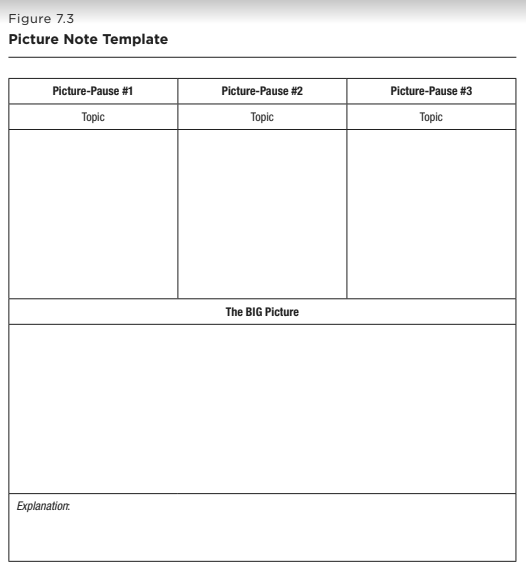Picture Notes
What It Is
Picture Notes can provide an excellent way for students to stop and process what they have learned. They are meant to accompany written notes, not to completely replace them. During selected pause points, students create a picture that illustrates the concepts being learned.
For example, during their first “picture-pause,” students might be asked to illustrate the first of three theories on what causes inflation. To draw their picture, students have to effectively consolidate the concepts presented and then be able to explain their picture to a peer. For students who have only a partial understanding of what has been presented, the sharing is essential, because students get to add to each others’ understandings in between each picture-pause. These picture-pauses, and the accompanying interactions, add to each student’s final understanding of the “big picture” drawn in the final box.
How It Works
- Select strategic pause points during your presentation—points when students will stop, process what they have learned, and draw a picture that illustrates these concepts. Be sure to emphasize that skill in drawing is not what is important. The picture-pause and the sharing can be limited to about four minutes.
- Ask students to share their picture with a peer (preselected or randomly selected) and to keep track of any questions they have. Circulate to get a feel for whether or not students are comprehending the topics presented.
- Address any questions that emerge from the picture-pause.
- Toward the end of the lesson, ask students to consolidate what they’ve learned into a final drawing that captures the “big picture,” along with a summary statement below the picture.
- You can debrief the “big picture” portion in a Chalkboard Splash and a search for similarities, differences, and surprises, or in a small-group discussion, followed by individuals sharing their “big picture.”
How to Ensure Higher-Order Thinking
Don’t limit Picture Notes to concrete things that can be drawn relatively easily. When students visually represent concepts presented using pictures, they have to wade through information and consolidate this into an image. Encourage students to use symbolism to capture concepts that are abstract as well as concrete. When you notice that a student excels in capturing some of the more abstract concepts in his or her Picture Notes, ask that student to share the Picture Notes with the class and to explain the symbolism behind them. Ask students to create a final Picture Note that addresses the “big picture” of the lesson and then to explain it with a caption.

Source
Himmele P., and Himmele, W. Total Participation Techniques: Making Every Student an Active Learner. ASCD, 2017, pp.97, 99-100.
